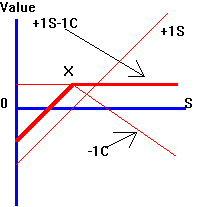![]() COVERED POSITIONS
COVERED POSITIONS
The purpose of this lesson is to understand each of the following positions by recreating them yourself in the form of an Option Profit Diagram. The covered position exercises provide the primitives of an important technique in modern risk management problems.
In this exercise you will learn how an initial exposure changes when a derivative contract is overlaid on top of the initial position.
By working through the examples yourself using the Option Payoff module you will learn how the exposure changes from initial position to final payoff profile.
The second type of option position is called a covered or hedged position. A covered position requires trading both the underlying stock and an option. That is, you write a covered call when you sell a call and buy the stock. In this case, if the call is exercised, you are "covered" in that you have the stock to deliver. Covered positions are also called hedged positions.
The payoff from a covered call position is engineered from the stock and the call option as shown in the following figure.
Covered Call

The thin lines reflect the payoff from being long one share (+1S) and writing one call option (-1C). The payoff from the portfolio of +1S - 1C is represented by the bold graph which is constructed by summing over the two components.
Module Steps:
In the module first click on Restart to clear whatever previous work was present. Then enter a long position in the underlying asset. To do this type 1 in the textbox beside Underlying Qty and then click on Plot.
Next click on the Call Price beside strike 50, followed by clicking on the << button once. Your picture should now be the Covered Call profit diagram.
Repeat now by clicking on Restart, clear the Underlying Qty text box from 1 to 0, and then click on the Put Price with strike 50
This payoff is identical to the payoff obtained from writing a naked put option, which shows that the payoff from writing a naked put can be engineered synthetically by writing one call option (payoff diagram -1C) and buying one stock (payoff diagram +1S).
Click on Restart so no position is open.
One can also vary the ratio of calls sold to stocks bought. This leads to a variable ratio hedge, where the ratio is the number of options per stock. Online, you can vary the number of options per stock and observe the resulting payoffs.
Online: Select from the drop down menu the Call Ratio Spread. Observe how this was constructed by inspecting the Call Qty column carefully.
For example, a 2:1 call ratio hedge would require buying one stock and buying two calls that are out of the money.
By experimenting online you will observe how you can engineer different types of payoff exposures merely by altering the hedge ratios.
The reverse of such hedge ratios, for example sell one stock and buy two calls, is called a reverse call ratio hedge. Equivalent exposures can also be engineered with puts.
Another example of a covered position is a protected short sale, in which you short the stock but buy a call. Online, you can experiment with the types of exposure profiles that are feasible.
OS
Financial Trading System,
Restart to return home
©2003
OS Financial Trading System